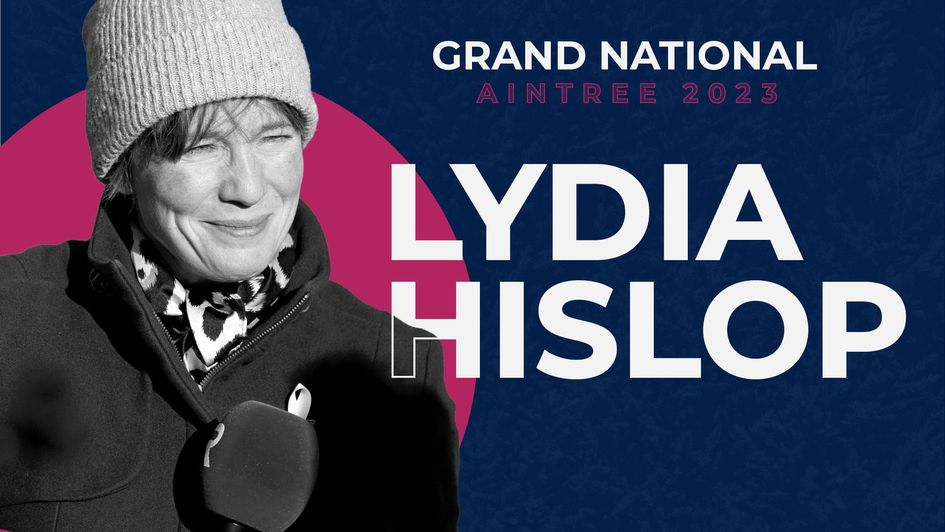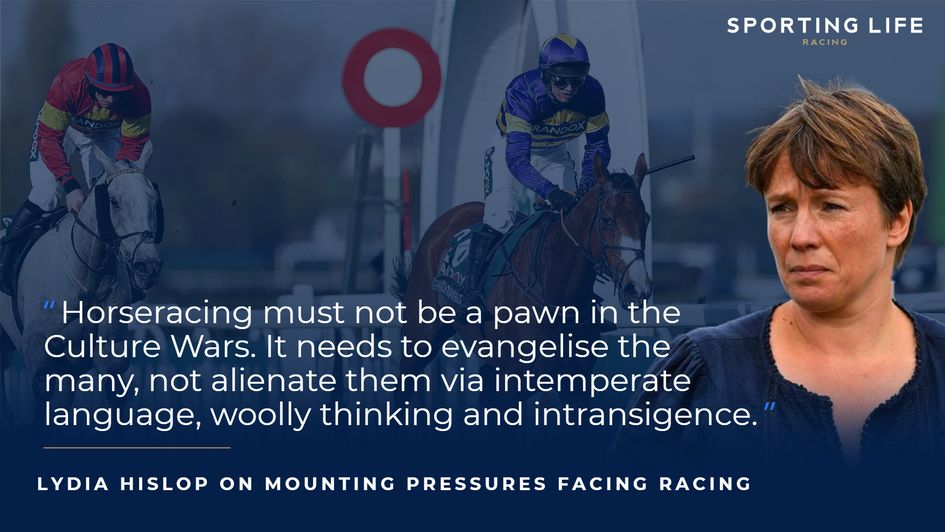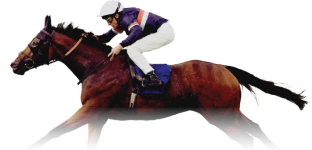In her column published on Sunday, Lydia Hislop looked at the mounting pressures facing racing following the protests at Aintree and subsequent coverage and looked at what response was needed. Now she focuses on the future of Grand National itself.
The Grand National must evolve again. The chaos of the first two fences this year, in which eight horses either fell or unseated their rider – and one of whom, Hill Sixteen, sadly lost his life – disturbed many sincere fans of the sport. There is a consensus among all but the most entrenched that further change, a decade on from the last significant reforms, is both inevitable and necessary.
All sensible ideas must be on the table, including the reduction of the totemic field size of 40 – an alteration suggested, and rejected, on more than one occasion previously. Yet data shows an ineluctably direct correlation between larger fields and a greater proportion of falls/unseats.
The start also needs an urgent fix. The key objective must be to reduce the speed and disorder with which the runners meet that first obstacle. Any reduction in fence height would have the opposite effect to that of popular imagination, because easier fences can be negotiated at greater speed. Just like the road-traffic mantra says: speed kills.
One option to slow things down could be to move the start even closer to the first fence, like the Becher or Topham Chases conducted over a shorter course of these famous fences. The National’s run-up was last reduced by 75 yards in 2013. Yet those races attract smaller fields and if the manner of starts continue in their present form, this measure could increase the risk of crowding.
An unintended consequence to the 2013 modifications, when the fences’ solid cores were replaced with plastic and their landing sides levelled out to eliminate steeper drops towards the inner rail – seems to have been to embolden over time more jockeys to steer their mounts on that inside line. 20 into the space for 12 does not go. Yet Cause Of Causes is the only horse to have raced down the inner early on to hit the first three in the past ten years, so it’s not even demonstrably beneficial.
Perhaps first-take standing starts could be introduced for all races over the National fences? Not as a ‘take two’ when the original ‘walking’ start has failed, as currently, but as the mandatory system for that specific quintet of races. This will be unpopular among jockeys. Yet standing starts are partly disliked because they’re a fallback option, frustrating those riders who had a good position for ‘take one’.
Their other argument is races are lost via a standing start. Yet data analysis of National results since 2013 shows that just ten of the 27 horses racing in the first three by the sixth fence managed to complete the course and just one – Magic Of Light, runner-up in 2019 – finished in the first three. So, jostling for a forward position at the first is likely to be self-defeating, making a standing-start proposal more viable.
This positional information, provided to Aintree by analyst Simon Rowlands, was also presented to jockeys in an improved pre-race safety briefing delivered by former National winners Ruby Walsh, Sir Anthony McCoy, Barry Geraghty and Mick Fitzgerald. Unfortunately, this excellent initiative was probably overlaid for many of its recipients by the pre-race turmoil that would shortly follow this year.
Another reason standing starts are disliked is because they can trigger uncooperative horses. So, these horses should be removed in advance. The National Fence Review Panel already assesses all entries for the National, Topham and Foxhunters’ Chases in terms of their jumping ability, completion record, existing form, scale of experience and any absence from the track. It has the power to exclude horses.
That reach could be extended to include any horse recorded by starting officials to have given trouble in the preceding 18 months. Again, cue outcry from individual connections. But the Scottish or Irish versions, where the starts are neither so febrile nor so race-defining, would still be open to such horses.
Let’s be honest: “walking starts” are a total misnomer anyway, and particularly when 40 runners are involved. As the line of horses rounds the bend to face the starter, even if those horses on the inside rail are walking – and invariably most won’t be – the ones on the outer will be cantering to keep up.
Look also at how far back from the starting tape the field began to assemble this year, gathering pace before they raced past the starter’s rostrum. Analysis of National starts since 2013 by Rowlands which you can read here shows the field has set off for the first fence at a notably faster speed for two successive years now.
Yet a number of starts were unsatisfactory at the Cheltenham Festival, too. Perhaps the dynamic between the BHA’s starting team and jockeys collectively needs examining because there is clearly work to be done. For the National, it appeared that promptness of dispatch had somehow overridden any concern for appropriate speed. Of course, this was an extremely pressurised situation – but it showed.
Which leads me to a more delicate point – and one that I acknowledge relies on hindsight. I raise it not as criticism of those at the sharp end, which was clearly extraordinarily challenging, but because this scenario will inevitably be faced again. That the National off-time was delayed little more than 14 minutes despite the protests drew broad praise in its aftermath. Yet might a steadier recovery be a better future response?
When the delay was announced, those attending the horses responded in different ways, depending on what they felt was best for each individual animal. Some horses were taken back to the racecourse stables; some went to the cool-down area to be misted with water; others merely had their girths loosened and continued to walk around the paddock. Jockeys were held back in the weighing room.
When the go-ahead was given and the jockeys were sent out, the horses had to be quickly recovered from their disparate locations. Some were still entering the paddock as others were already out on the track, taken by their jockeys to look at the first fence as part of their typical pre-race ritual. Aintree opted to drop the parade and National Anthem. Instead, the main body of horses began to gather near the water-jump in front of the main stands. They would be asked to turn twice before being released by the starter to race.
Aintree’s operational team worked closely throughout with Merseyside Police and, after the two waves of protest had been cleared – first near the Canal Turn and then at the second fence – there would have been a narrow window of opportunity in which they could confidently stage the race. (I am told TV commitments did not affect these timings.) Those teams were no doubt executing well-considered plans in a controlled and calm manner.
Yet I find it difficult to believe that the tense and unusual build-up – affecting the atmosphere of the crowd, animals sensitive to their environment, and the composure of those interacting with them – did not contribute to a turbulent race. The statistically unusual number of departures over the first two fences – eight, as opposed to a total of 17 during the comparable period since 2013 – is strongly suggestive. Fall analysis, as routinely carried out by the industry routinely, will provide more facts, however.
If anything like this were to happen again, the sport must be better prepared to respond. However, it might even be that this one experience is learning enough because there was even a sense of greater resilience from those working at Ayr on Saturday, albeit the impact of the protest was far smaller and the focus less intense.
The future of the National is in all our hands. For racehorse owners, trainers and jockeys, in realising their individual actions – such as entering only suitable horses, or pulling them up when their competitive chance has gone – are this sport’s reputation in visible form. For the regulatory authority, in carrying out its duties with clarity, consistency and composure. For the racecourse team, in ensuring participants are as prepared as they are, and that their public-facing communications are plain and timely. For all of the above, in working together for a common goal. For us fans, even, in the language we use when talk about it.
An institution of British cultural and sporting heritage, one that’s almost two centuries old, is at stake. If it is to retain broad support as the sport’s shop window, it needs more closely to resemble what you see if you walk through the door.
More from Sporting Life
- Racecards
- Fast results
- Full results and free video replays
- Horse racing news
- Horse racing features
- Download our free iOS and Android app
- Football and other sports tips
- Podcasts and video content
Safer gambling
We are committed in our support of safer gambling. Recommended bets are advised to over-18s and we strongly encourage readers to wager only what they can afford to lose.
If you are concerned about your gambling, please call the National Gambling Helpline / GamCare on 0808 8020 133.
Further support and information can be found at begambleaware.org and gamblingtherapy.org











